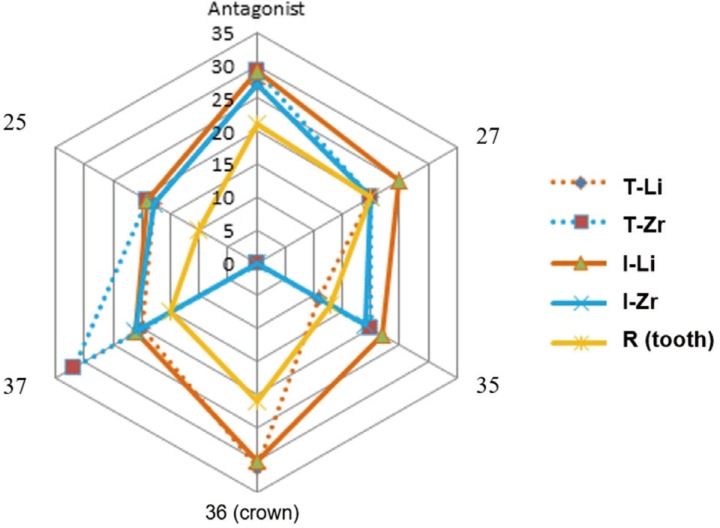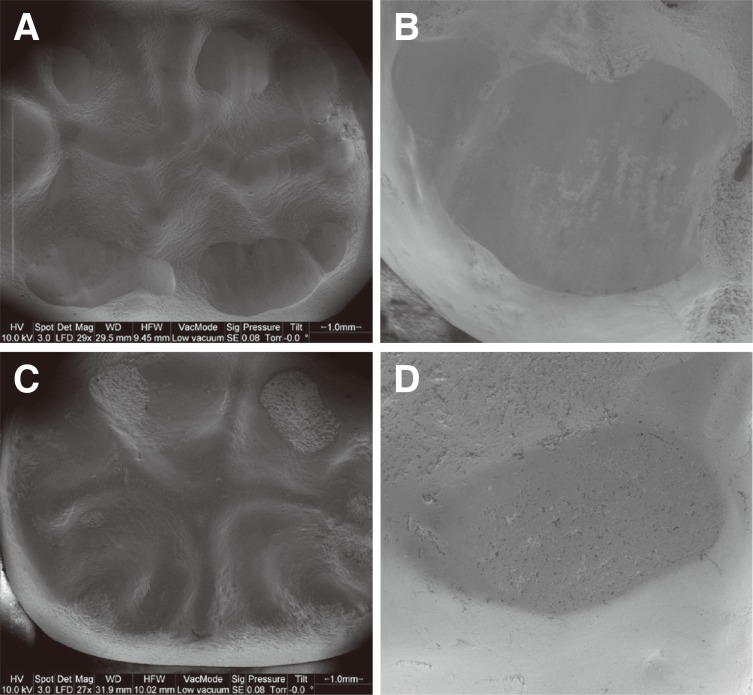J Adv Prosthodont.
2020 Feb;12(1):1-8. 10.4047/jap.2020.12.1.1.
Influence of zirconia and lithium disilicate tooth- or implant-supported crowns on wear of antagonistic and adjacent teeth
- Affiliations
-
- 1Department of Prosthetic Dentistry, UKR University Hospital Regensburg, Regensburg, Germany. verena.preis@ukr.de
- KMID: 2470791
- DOI: http://doi.org/10.4047/jap.2020.12.1.1
Abstract
- PURPOSE
To investigate the influence of crown material (lithium-disilicate, 3Y-TZP zirconia) and abutment type (rigid implant, resin tooth with artificial periodontium) on wear performance of their antagonist teeth and adjacent teeth.
MATERIALS AND METHODS
A mandibular left first molar (#36) with adjacent human teeth (mandibular left second premolar: #35, mandibular left second molar: #37) and antagonistic human teeth (maxillary left second premolar: #25, maxillary left first molar: #26, maxillary left second molar: #27) was prepared simulating a section of the jaw. Samples were made with extracted human molars (Reference), crowned implants (Implant), or crowned resin tooth analogues (Tooth). Crowns (tooth #36; n = 16/material) were milled from lithium-disilicate (Li, IPS e.max CAD) or 3Y-TZP zirconia (Zr, IPS e.max ZirCAD, both Ivoclar Vivadent). Thermal cycling and mechanical loading (TCML) in the chewing simulator were applied simulating 15 years of clinical service. Wear traces were analyzed (frequency [n], depth [µm]) and evaluated using scanning electron pictures. Wear results were compared by one-way-ANOVA and post-hoc-Bonferroni (α = 0.05).
RESULTS
After TCML, no visible wear traces were found on Zr. Li showed more wear traces (n = 30-31) than the reference (n = 21). Antagonistic teeth #26 showed more wear traces in contact to both ceramics (n = 27-29) than to the reference (n = 21). Strong wear traces (> 350 µm) on antagonists and their adjacent teeth were found only in crowned groups. Abutment type influenced number and depth of wear facets on the antagonistic and adjacent teeth.
CONCLUSION
The clinically relevant model with human antagonistic and adjacent teeth allowed for a limited comparison of the wear situation. The total number of wear traces and strong wear on crowns, antagonistic and adjacent teeth were influenced by crown material.
Figure
Reference
-
1. Pathan MS, Kheur MG, Patankar AH, Kheur SM. Assessment of antagonist enamel wear and clinical performance of full-contour monolithic zirconia crowns: One-year results of a prospective study. J Prosthodont. 2019; 28:e411–e416. PMID: 30256495.
Article2. Rabel K, Spies BC, Pieralli S, Vach K, Kohal RJ. The clinical performance of all-ceramic implant-supported single crowns: A systematic review and meta-analysis. Clin Oral Implants Res. 2018; 29:196–223. PMID: 30306684.
Article3. Rauch A, Reich S, Dalchau L, Schierz O. Clinical survival of chair-side generated monolithic lithium disilicate crowns:10-year results. Clin Oral Investig. 2018; 22:1763–1769.
Article4. Ludovichetti FS, Trindade FZ, Werner A, Kleverlaan CJ, Fonseca RG. Wear resistance and abrasiveness of CAD-CAM monolithic materials. J Prosthet Dent. 2018; 120:318.e1–318.e8. PMID: 30097264.
Article5. Hayashi S, Homma S, Takanashi T, Hirano T, Yoshinari M, Yajima Y. Wear properties of esthetic dental materials against translucent zirconia. Dent Mater J. 2019; 38:250–256. PMID: 30541995.
Article6. Chong BJ, Thangavel AK, Rolton SB, Guazzato M, Klineberg IJ. Clinical and laboratory surface finishing procedures for zirconia on opposing human enamel wear: A laboratory study. J Mech Behav Biomed Mater. 2015; 50:93–103. PMID: 26116957.
Article7. Preis V, Grumser K, Schneider-Feyrer S, Behr M, Rosentritt M. Cycle-dependent in vitro wear performance of dental ceramics after clinical surface treatments. J Mech Behav Biomed Mater. 2016; 53:49–58. PMID: 26313248.
Article8. Preis V, Behr M, Handel G, Schneider-Feyrer S, Hahnel S, Rosentritt M. Wear performance of dental ceramics after grinding and polishing treatments. J Mech Behav Biomed Mater. 2012; 10:13–22. PMID: 22520415.
Article9. D'Arcangelo C, Vanini L, Rondoni GD, Vadini M, De Angelis F. Wear evaluation of prosthetic materials opposing themselves. Oper Dent. 2018; 43:38–50. PMID: 28857711.10. D'Arcangelo C, Vanini L, Rondoni GD, De Angelis F. Wear properties of dental ceramics and porcelains compared with human enamel. J Prosthet Dent. 2016; 115:350–355. PMID: 26553254.11. Gou M, Chen H, Kang J, Wang H. Antagonist enamel wear of tooth-supported monolithic zirconia posterior crowns in vivo: A systematic review. J Prosthet Dent. 2019; 121:598–603. PMID: 30509545.12. Wiegand A, Credé A, Tschammler C, Attin T, Tauböck TT. Enamel wear by antagonistic restorative materials under erosive conditions. Clin Oral Investig. 2017; 21:2689–2693.
Article13. Fathy SM, Swain MV. In-vitro wear of natural tooth surface opposed with zirconia reinforced lithium silicate glass ceramic after accelerated ageing. Dent Mater. 2018; 34:551–559. PMID: 29361309.
Article14. Zheng J, Zeng Y, Wen J, Zheng L, Zhou Z. Impact wear behavior of human tooth enamel under simulated chewing conditions. J Mech Behav Biomed Mater. 2016; 62:119–127. PMID: 27183431.
Article15. Nakashima J, Taira Y, Sawase T. In vitro wear of four ceramic materials and human enamel on enamel antagonist. Eur J Oral Sci. 2016; 124:295–300. PMID: 27059093.
Article16. Zandparsa R, El Huni RM, Hirayama H, Johnson MI. Effect of different dental ceramic systems on the wear of human enamel: An in vitro study. J Prosthet Dent. 2016; 115:230–237. PMID: 26548885.17. Lee A, Swain M, He L, Lyons K. Wear behavior of human enamel against lithium disilicate glass ceramic and type III gold. J Prosthet Dent. 2014; 112:1399–1405. PMID: 25311791.
Article18. Hartkamp O, Lohbauer U, Reich S. Antagonist wear by polished zirconia crowns. Int J Comput Dent. 2017; 20:263–274. PMID: 28852744.19. Esquivel-Upshaw JF, Kim MJ, Hsu SM, Abdulhameed N, Jenkins R, Neal D, Ren F, Clark AE. Randomized clinical study of wear of enamel antagonists against polished monolithic zirconia crowns. J Dent. 2018; 68:19–27. PMID: 29042241.
Article20. Yang SW, Kim JE, Shin Y, Shim JS, Kim JH. Enamel wear and aging of translucent zirconias: In vitro and clinical studies. J Prosthet Dent. 2019; 121:417–425. PMID: 30391060.21. Lohbauer U, Reich S. Antagonist wear of monolithic zirconia crowns after 2 years. Clin Oral Investig. 2017; 21:1165–1172.22. Rashid H, Sheikh Z, Misbahuddin S, Kazmi MR, Qureshi S, Uddin MZ. Advancements in all-ceramics for dental restorations and their effect on the wear of opposing dentition. Eur J Dent. 2016; 10:583–588. PMID: 28042280.
Article23. Rosentritt M, Behr M, Scharnagl P, Handel G, Kolbeck C. Influence of resilient support of abutment teeth on fracture resistance of all-ceramic fixed partial dentures: an in vitro study. Int J Prosthodont. 2011; 24:465–468. PMID: 21909489.24. Scharnagl P, Behr M, Rosentritt M, Leibrock A, Handel G. Simulation of physiological tooth mobility in in-vitro stress examination of dental restorations in the masticator. J Dent Res. 1998; 77:1260.25. Rosentritt M, Behr M, van der Zel JM, Feilzer AJ. Approach for valuating the influence of laboratory simulation. Dent Mater. 2009; 25:348–352. PMID: 18829097.
Article26. Rosentritt M, Siavikis G, Behr M, Kolbeck C, Handel G. Approach for valuating the significance of laboratory simulation. J Dent. 2008; 36:1048–1053. PMID: 18848380.
Article27. Lambrechts P, Braem M, Vuylsteke-Wauters M, Vanherle G. Quantitative in vivo wear of human enamel. J Dent Res. 1989; 68:1752–1754. PMID: 2600255.
Article28. Preis V, Weiser F, Handel G, Rosentritt M. Wear performance of monolithic dental ceramics with different surface treatments. Quintessence Int. 2013; 44:393–405.29. Lawson NC, Janyavula S, Syklawer S, McLaren EA, Burgess JO. Wear of enamel opposing zirconia and lithium disilicate after adjustment, polishing and glazing. J Dent. 2014; 42:1586–1591. PMID: 25257823.
Article30. Rosentritt M, Schneider-Feyrer S, Behr M, Preis V. In vitro shock absorption tests on implant-supported crowns: Influence of crown materials and luting agents. Int J Oral Maxillofac Implants. 2018; 33:116–122. PMID: 28518187.
Article31. Tsumita M, Kokubo Y, Ohkubo C, Sakurai S, Fukushima S. Clinical evaluation of posterior all-ceramic FPDs (Cercon): a prospective clinical pilot study. J Prosthodont Res. 2010; 54:102–105. PMID: 20117970.
Article32. Teichmann M, Wienert AL, Rückbeil M, Weber V, Wolfart S, Edelhoff D. Ten-year survival and chipping rates and clinical quality grading of zirconia-based fixed dental prostheses. Clin Oral Investig. 2018; 22:2905–2915.
Article33. Schmitter M, Mueller D, Rues S. Chipping behaviour of all-ceramic crowns with zirconia framework and CAD/CAM manufactured veneer. J Dent. 2012; 40:154–162. PMID: 22197634.
Article34. Rosentritt M, Preis V, Behr M, Hahnel S, Handel G, Kolbeck C. Two-body wear of dental porcelain and substructure oxide ceramics. Clin Oral Investig. 2012; 16:935–943.
Article35. Preis V, Behr M, Kolbeck C, Hahnel S, Handel G, Rosentritt M. Wear performance of substructure ceramics and veneering porcelains. Dent Mater. 2011; 27:796–804. PMID: 21524788.
Article36. Preis V, Grumser K, Schneider-Feyrer S, Behr M, Rosentritt M. The effectiveness of polishing kits: influence on surface roughness of zirconia. Int J Prosthodont. 2015; 28:149–151. PMID: 25822299.
Article37. Preis V, Schmalzbauer M, Bougeard D, Schneider-Feyrer S, Rosentritt M. Surface properties of monolithic zirconia after dental adjustment treatments and in vitro wear simulation. J Dent. 2015; 43:133–139. PMID: 25174949.
Article38. Bartolo D, Cassar G, Al-Haj Husain N, Özcan M, Camilleri J. Effect of polishing procedures and hydrothermal aging on wear characteristics and phase transformation of zirconium dioxide. J Prosthet Dent. 2017; 117:545–551. PMID: 27881307.
Article39. Al-Haj Husain N, Camilleri J, Özcan M. Effect of polishing instruments and polishing regimens on surface topography and phase transformation of monolithic zirconia: An evaluation with XPS and XRD analysis. J Mech Behav Biomed Mater. 2016; 64:104–112. PMID: 27497266.
Article40. Al-Haj Husain N, Özcan M. A study on topographical properties and surface wettability of monolithic zirconia after use of diverse polishing instruments with different surface coatings. J Prosthodont. 2018; 27:429–442. PMID: 27469615.
Article41. Alghazzawi TF, Lemons J, Liu PR, Essig ME, Bartolucci AA, Janowski GM. Influence of low-temperature environmental exposure on the mechanical properties and structural stability of dental zirconia. J Prosthodont. 2012; 21:363–369. PMID: 22372432.
Article
- Full Text Links
- Actions
-
Cited
- CITED
-
- Close
- Share
- Similar articles
-
- Wear of primary teeth caused by opposed all-ceramic or stainless steel crowns
- 3D quantitative analysis and SEM qualitative analysis of natural antagonist enamel opposing CAD-CAM monolithic zirconia or lithium disilicate tooth-supported crowns versus enamel opposing natural enamel
- Fracture resistance of implant- supported monolithic crowns cemented to zirconia hybrid-abutments: zirconia-based crowns vs. lithium disilicate crowns
- In vitro performance and fracture resistance of novel CAD/CAM ceramic molar crowns loaded on implants and human teeth
- A study on the in-vitro wear of the natural tooth structure by opposing zirconia or dental porcelain



